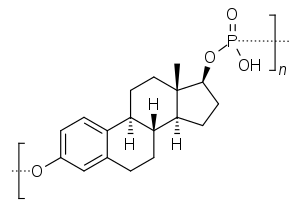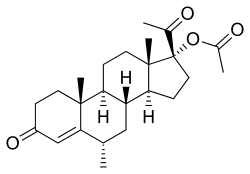Polyestradiol phosphate/medroxyprogesterone acetate
Polyestradiol phosphate/medroxyprogesterone acetate (PEP/MPA) is a combination of polyestradiol phosphate (PEP), an estrogen, and medroxyprogesterone acetate (MPA), a progestin, which was studied in the 1960s as a long-lasting combined injectable contraceptive for women but was never marketed.[1][2][3] It was administered by intramuscular injection once every 3 months and contained 40 mg PEP and 150 mg MPA.[1][2][3] The combination was studied in a sample of 99 premenopausal women and was found to be effective in preventing pregnancy, but caused menstrual irregularities similar to those of MPA alone as a progestogen-only injectable contraceptive.[1][2][3] PEP was included in the formulation to prevent estrogen deficiency caused by MPA during long-term contraceptive therapy.[2]
 | |
 | |
| Combination of | |
|---|---|
| Polyestradiol phosphate | Estrogen |
| Medroxyprogesterone acetate | Progestogen |
| Clinical data | |
| Other names | PEP/MPA |
| Routes of administration | Intramuscular injection |
See also
References
- Joseph William Goldzieher; Kenneth Fotherby (1994). Pharmacology of the contraceptive steroids. Raven Press. p. 154. ISBN 978-0-7817-0097-9.
- Zañartu J, Rice-Wray E, Goldzieher JW (October 1966). "Fertility control with long-acting injectable steroids. A preliminary report". Obstet Gynecol. 28 (4): 513–5. doi:10.1097/00006250-196610000-00011 (inactive 2020-05-29). PMID 5925038.
- Harry Beckman (1967). The Year Book of Drug Therapy. Year Book Publishers.
| Progestogens (and progestins) |
| ||||
|---|---|---|---|---|---|
| Antiprogestogens |
| ||||
| |||||
| ER |
| ||||||
|---|---|---|---|---|---|---|---|
| GPER |
| ||||||
| |||||||
| PR |
| ||||||
|---|---|---|---|---|---|---|---|
| mPR (PAQR) |
| ||||||
| |||||||